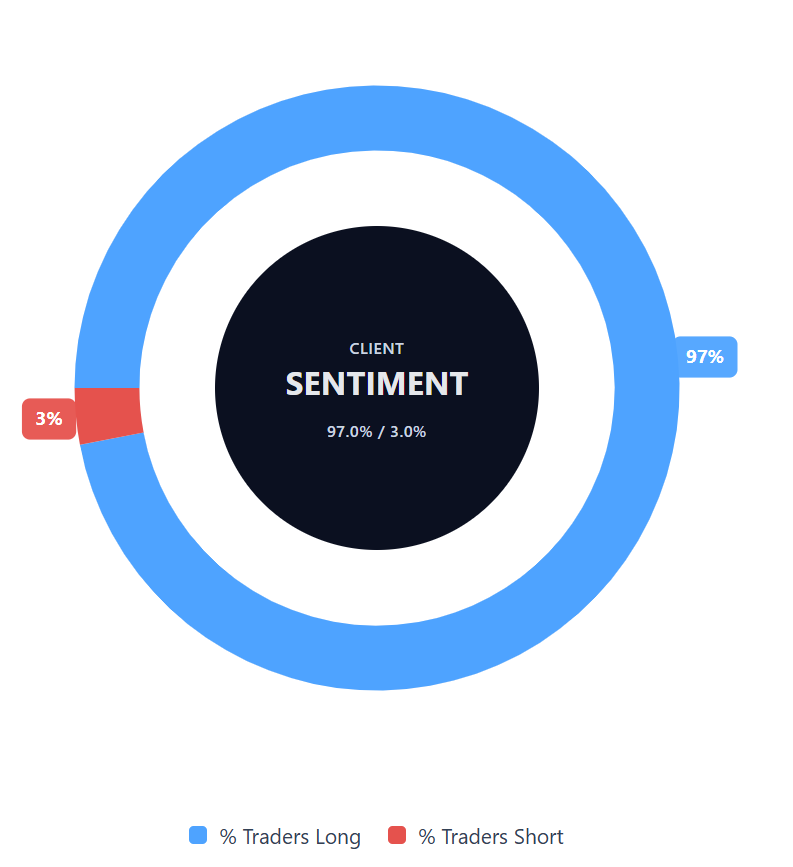PepsiCo stock forecast: Third-party outlook
PepsiCo (PEP) was trading at $139.62 as of 10:54am UTC on 7 October 2025, sitting near the lower end of its intraday range of $139.43-$143.20.
The stock remains well below its 52-week high of $177.50 and above its 52-week low of $127.60.
The stock remains under pressure following Elliott Investment Management’s $4bn activist stake, disclosed in September, with the hedge fund reportedly urging operational changes such as a potential spin-off of the bottling division (Benzinga, 6 October 2025).
According to Capital.com data, 96.98% of PepsiCo CFD positions are currently long, with 3.02% short (7 October 2025), indicating a prevailing bullish sentiment among traders.
This information is provided for general informational purposes only and does not constitute investment advice. Clients should always undertake their own investment research before making trading decisions.
PepsiCo stock forecast: Analyst price target view
JPMorgan Chase & Co. (house view)
JPMorgan lowered its price target to $151 from $157, maintaining a neutral rating. The firm expects limited sequential improvement ahead of third-quarter earnings, citing ongoing pressure from North American volume declines and weaker international performance amid activist investor Elliott Management’s proposed operational changes (MarketBeat, 6 October 2025).
Wells Fargo (equity research)
Wells Fargo revised its target to $150 from $154 and maintains an equal weight rating. The adjustment reflects concerns about sustained pricing pressures in Frito-Lay’s North American segment, where higher retail prices are impacting market share as consumers reduce discretionary snack purchases (MarketBeat, 25 September 2025).
Barclays (sector coverage)
Barclays cut its price target to $140 from $144, maintaining an equal weight rating as of 3 October 2025. The firm highlights structural challenges in North American beverage market trends and expects continued headwinds from slower international organic sales growth (TipRanks, 7 October 2025).
Citigroup (buy recommendation)
Citigroup continues to hold a buy rating with a price target of $165, down from $168. The firm cites PepsiCo’s strategic focus on wellness-oriented products and cost efficiencies, while acknowledging short-term pressures from inflationary supply chain costs and shifts in consumer spending (AInvest, 25 September 2025).
UBS Group (sector specialist)
UBS retains a buy rating with a $170 target, reduced from $175. The firm has revised its volume outlook to reflect weaker international demand, but emphasises PepsiCo’s relatively stronger long-term positioning versus global peers, expecting organic growth to align with or outperform competitors despite near-term North American challenges (MarketBeat, 15 September 2025).
Predictions and third-party forecasts are inherently uncertain, as they can’t account for unexpected market developments. Past performance should not be considered a reliable indicator of future results.
PEP stock price: Technical overview
On the daily chart, PepsiCo (PEP) is trading at $139.62, below its key moving-average cluster – the 20-, 50-, 100- and 200-day SMAs at approximately 142, 144, 139 and 143, respectively. The price is hovering near the 100-day line while remaining below the shorter-term averages. The 14-day RSI stands at 41.48, indicating neutral conditions – neither oversold nor overbought – while momentum remains muted, with the ADX at 13.37, signalling weak trend strength.
The first resistance area to monitor lies around $152.45, based on the classic pivot level. A sustained daily close above this threshold could bring $164.46 into focus as the next significant resistance zone. Beyond that, $183.14 marks the upper boundary of the classic resistance range.
On the downside, initial support appears near $145.79, followed by the 100-day SMA region around $139. A decisive move below the 100-day average could open the way toward the $133.78 support level, aligning with the S1 classic pivot point (TradingView, 7 October 2025).
This technical overview is provided for informational purposes only and does not constitute financial advice or a recommendation to buy or sell any instrument.
PepsiCo share price history
PepsiCo (PEP) began its recent price movement near $161 in early October 2023, advancing steadily through the autumn to reach a high of $182.10 on 17 May 2024. The stock remained above $170 for much of 2024, influenced by steady consumer demand and consistent quarterly performance.
However, the second half of 2024 brought increasing pressure as volume declines in North American beverages became more evident, with shares retreating from their May highs to end the year near $152.
As of 6 October 2025, PepsiCo closed at $139.62, marking a decline of around 8.1% year to date and approximately 18.3% below its 2024 peak. The performance reflects ongoing challenges from evolving consumer preferences, operational headwinds in certain divisions, and continued scrutiny of PepsiCo’s strategic direction under activist pressure.
Past performance is not a reliable indicator of future results.
Capital.com’s client sentiment for PepsiCo CFDs
Capital.com client positioning in PepsiCo CFDs currently indicates predominantly bullish sentiment, with 97% of positions long and 3% short (7 October 2025). The data suggests that most clients are positioned for potential upside despite recent price softness.
This snapshot reflects live open positions on the Capital.com platform and is subject to change as market conditions evolve.

FAQ
Is PepsiCo a good stock to buy?
This depends on individual objectives, risk tolerance, and overall market view. Analysts express a range of opinions, from neutral to positive, noting PepsiCo’s established brand strength and operational resilience, alongside challenges linked to shifting consumer trends and activist investor influence. Anyone considering exposure to PepsiCo through contracts for difference (CFDs) or other instruments should conduct independent research and understand the associated risks. CFDs are traded on margin, and leverage can amplify both profits and losses.
Could PepsiCo stock go up or down?
Like all equities, PepsiCo’s share price is affected by a variety of factors, including earnings results, inflation trends, consumer spending, and investor sentiment. Price movements are a normal part of market activity and can occur in either direction depending on broader economic conditions and company-specific developments.
Should I invest in PepsiCo stock?
Capital.com does not provide investment advice. Whether PepsiCo is suitable for an individual portfolio depends on personal financial circumstances, investment goals, and risk appetite. It’s important to review independent research and consider potential downside risk before making any investment decision.
What factors could affect PepsiCo’s future performance?
Future performance may depend on broader economic and company-specific influences, such as commodity prices, interest rates, consumer demand, and business strategy. Company-led initiatives – including cost optimisation, product diversification and responses to activist investor proposals – could also play a role.